Firestick plant (Euphorbia tirucallis) is a succulent that is drought tolerant once established, making it easy to care for. They can be a striking, colorful, low-maintenance addition to your outdoor garden or indoor houseplant collection.
Plant it in well-draining soil, and water thoroughly when it’s dry 2-3” deep. The stems will turn bright yellow, orange, pink, and red in full sun, and the color intensifies in cooler weather. Indoors they may revert to green without adequate lighting. Precautions: The milky white sap can cause significant eye pain and skin irritation.
In this complete guide on firestick plant care, I’ll help you learn what it takes to keep them growing and thriving for decades to come.
I’ll give you details on all of the basics, like water, sun, and soil. Plus my expert tips for how to propagate, prune, control pests, and so much more.
Firestick Plant Quick Care Overview
| Botanical name: | Euphorbia tirucalli ‘Sticks Of Fire’ |
| Classification: | Succulent plant |
| Common names: | Firestick Plant, Sticks of Fire, Red Pencil Tree, Pencil Cactus |
| Hardiness zones: | 10+ |
| Temperature: | 60-95°F |
| Flowers: | Small yellow clusters, blooms fall-spring |
| Light: | Full sun, bright light indoors |
| Water: | Allow soil to dry between waterings, do not overwater |
| Humidity: | Little to none |
| Fertilizer: | General purpose plant food spring-summer |
| Soil: | Fast-draining, sandy soil |
| Common pests: | Mealybugs, aphids, spider mites |
Information About The Firestick Plant
Firestick plant, Euphorbia tirucalli ‘Sticks of Fire’, is a type of succulent that requires minimal care. Also commonly called a “red pencil tree”, this is a cultivar of pencil cacti, and is native to Africa.
- The common name comes from the pencil-thin branches that turn bright yellow, orange, pink, and red making them look like sticks that are on fire.
- Small leaves grow in the summer and drop off in the fall, leaving brightly colored bare stick-like branches behind.
- As they mature, the base of the trunk develops a woody, brown appearance, and a bark-like texture.
- It’s possible for them to grow into 30’ tall trees in the right climate outdoors, but most indoor specimens reach 6-8’ at most.
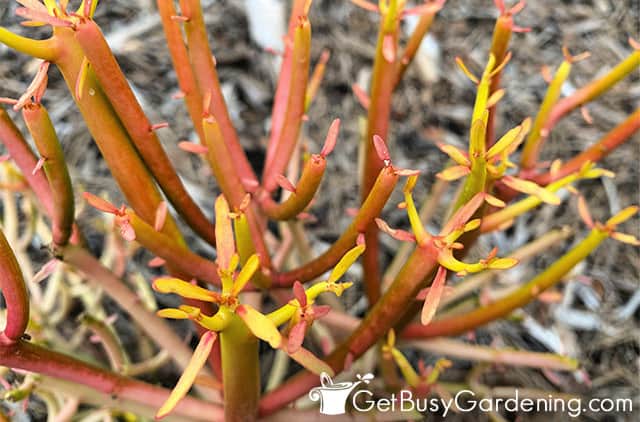
Firestick Plant Flowers
You may never see it happen indoors, even with the best care, but believe it or not, a firestick plant can flower.
Clusters of tiny, yellow blossoms can appear on the branch tips and joints at any time during the year, but they typically bloom in the winter.
The flowers are insignificant, but they’re attractive to butterflies, bees, and other pollinators.
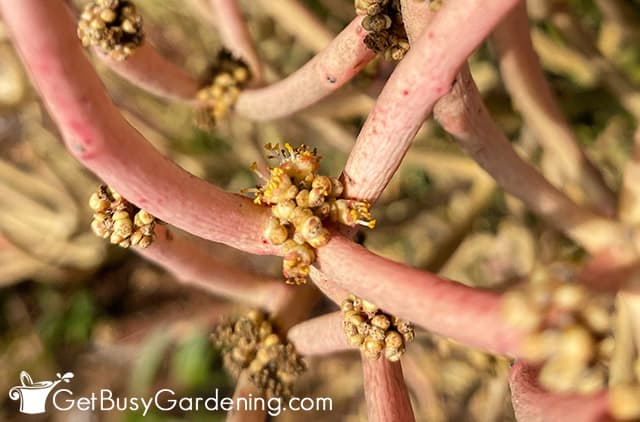
Toxicity
The firestick plant is toxic to both humans and animals. It can cause stomach and digestive upset if ingested, and also has a milky white latex sap that can be a skin and eye irritant.
Always wear gloves and eye protection when handling the plant, and be very careful not to get the sap in your eyes. You should thoroughly wash your hands and any tools that come in contact with the sap.
If you’re concerned, then keep it out of reach of pets and children. For more information about the toxicity, check out the ASPCA website.
Hardiness
Sticks of fire is not a frost hardy plant. It can only survive outside year-round in the warmest USDA hardiness zones of 10+.
They can tolerate lows of 30°F for short periods, but will suffer and die in prolonged frost or freezing weather.
Where To Grow A Firestick Plant
The best location to grow a firestick plant is somewhere very sunny and dry. They don’t do well with excess moisture, and require lots of light to get the bright color.
If it never drops below 30°F where you live, you can grow it outdoors year-round, and either plant it in the ground or in a container. Any pot with drainage is fine.
For colder areas, it’s best to keep them indoors as houseplants. You can put it outside during the summer, but be sure to move it back inside when temperatures drop below 60°F.
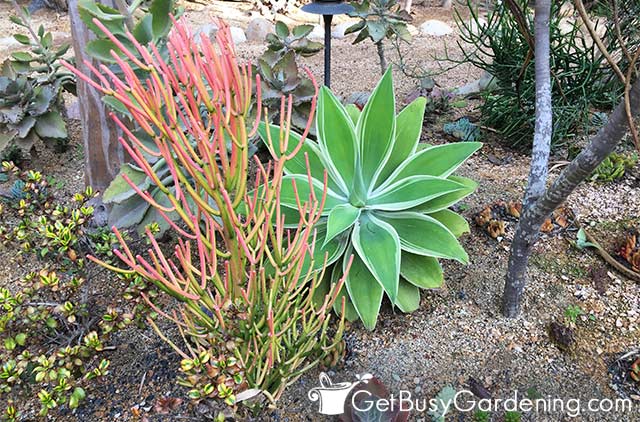
Firestick Plant Care Instructions
Now that you know the best locations to grow them, let’s talk about firestick plant care. These tips will help you learn what it takes to keep them healthy and happy year after year.
Light
Give your Euphorbia tirucalli ‘Sticks of Fire’ full sun outdoors to help trigger the vibrant red, orange, and yellow coloring. Indoors, provide it with bright light for at least 8 hours a day.
A south-facing window is best inside the house, but east or west can also work. Turn the plant once a month to promote balanced color and growth.
In shady or low-light conditions, the plant will lose its color and convert to green. If you have trouble providing enough from a natural source, a grow light is a great way to supplement.
Water
The best way to care for a firestick plant is to allow it to dry completely between drinks. It does not do well with soggy soil or wet feet, and consistent overwatering will cause root rot.
So wait until the medium is dry at least 2” down. Then water thoroughly until it drains out the bottom of the pot, and discard all excess right away so it’s never soaking.
If you have trouble, use a moisture meter to help you know exactly when it’s time to give it more.
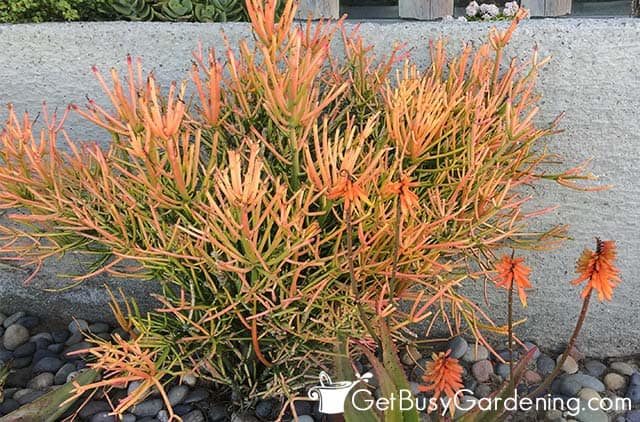
Humidity
Since they thrive in dry, arid climates, they do not like a lot of humidity. If you live in a place with higher humidity, you can water less often.
Temperature
The ideal temperature range for firestick plants is between 60-95°F, making them well-situated for most indoor environments and hot outdoor climates.
They can tolerate lows of 30°F for short periods of time, but prolonged freezing temps will cause damage to the foliage and branches, and eventually kill the plant.
On the other hand, they can easily tolerate highs of 100°F or more, especially when you keep them properly hydrated.
Cool temps will make the colors even more vivid. When it drops to 60-70°F in the fall and winter outdoors, the red and orange colors will become much more prominent.
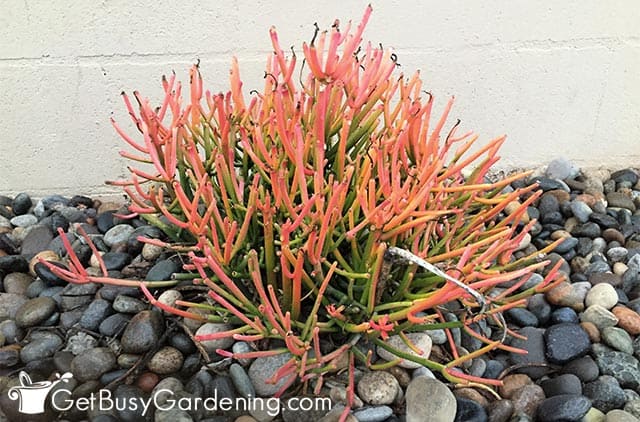
Fertilizer
Firestick plants don’t need a lot of fertilizer as part of their regular care, but the occasional feeding can help stimulate growth.
Use a general-purpose, organic houseplant food, or a compost tea once a month during the spring and summer. If you prefer, you could mix in granules instead of using a liquid.
Stop feeding it completely during the fall and winter to let your plant rest, otherwise it can cause weak and leggy growth.
Soil
Use a fast-draining, sandy soil for your firestick plant. A general-purpose mix can work too, but you should amend it to make it more porous and gritty.
To mix your own, combine 2 parts potting soil with 1 part perlite or pumice, and 1 part coarse sand.
Transplanting & Repotting
Young firestick plants tend to grow faster, especially with the proper care. So you may need to repot yours annually in the spring, or at least every 2-3 years.
When growth has dramatically slowed, or roots are poking through the bottom drainage holes, it’s time to size them up into a new pot.
Choose a container that’s 2-3” wider and deeper than the current one, with good drainage, and repot it at the same depth.
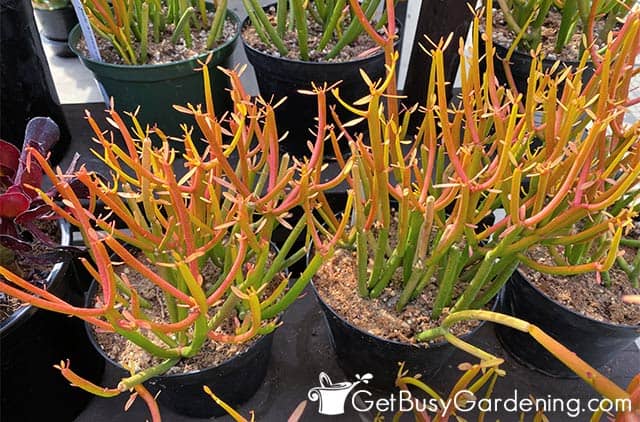
Pruning
You only need to worry about pruning your firestick plant if you want to control the size and shape, or to trim away dead branches.
The best time to tackle it is in the summer or fall, when the plant is a little drier. It can handle as much pruning as you like to manage the size, you can even top it to manage the height and promote bushy growth.
Use sharp, clean pruners, to make the cuts. Once you’re done, be sure to wash your gloves, tools, and hands with soap and water right away to remove the toxic sap.
Caution: You should always wear gloves, long sleeves, and safety glasses to protect you from the sap.
Pest Control Tips
Healthy red pencil trees rarely have issues with pests. However, sometimes spider mites, aphids, and mealybugs can become a problem, especially indoors.
Remove visible bugs with a blast of water from the hose, or dab them with a cotton swab dipped in rubbing alcohol.
You can also treat pests with neem oil or an organic insecticidal spray. I make my own by combining 1 teaspoon of mild liquid soap with 1 liter of water.
Firestick Plant Propagation Tips
Firestick plants are very quick and easy to propagate from stem cuttings. Take healthy branches, and dip the cut end in water to stop the milky sap from flowing.
Leave them out to dry and callous over a few days. Then dust the cut end with rooting hormone, and plant in a soilless or well-draining medium.
Keep them barely moist and in low light for 2-6 weeks, or until you start to see new growth on top.
Troubleshooting Firestick Plant Care Problems
Firestick plants are usually easy to care for, but over the years you may run into one of these common issues. Use my tips to help get them back into good health.
Firestick Plant Reverted To Green
Your sticks of fire plant will revert to green if you don’t give it enough sunlight. This can happen indoors during long, dark winters, or if it’s growing outdoors in the shade.
Ensure your plant receives 6 or more hours of bright light or direct sun daily. Grow lights can be very helpful if you have trouble providing enough inside.
Leggy Branches
Leggy branches are most commonly caused by lack of light, but it can also happen if you over-fertilize or feed them during the winter.
If new growth is spindly and sparse, move your plant to a brighter location, or add a grow light to help supplement. Fertilize only during the spring and summer, and stop during the winter.
Firestick Plant Not Growing
There are many reasons why your firestick plant may not be growing. It could be a lack of light, improper watering (either over or underwatering), or it’s severely pot-bound.
Provide plenty of bright light daily, and only water when the soil has dried 2″ deep or more.
If you see roots coming out of the bottom of the pot, it’s time to move it into a larger container to reinvigorate growth.
Plant Is Shriveling
Shriveling stems and leaves are most often a sign of under watering. In that case, the branches will appear droopy, dried, and deflated.
Give it a thorough drink to rehydrate it, then drain off the excess from the bottom of the pot.
Leaves / Stems Turning Brown
Browning can indicate a few different problems, like improper watering or sunburn. However, it is normal for the base of the main stem to turn brown with age.
While a firestick plants thrive in full sun, take care not to move yours from growing indoors to the full sun exposure outdoors without hardening them, or it can cause sunburn.
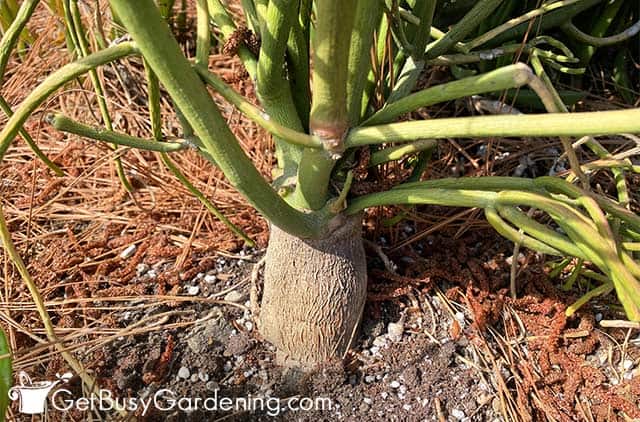
FAQs
Yes, you can touch a firestick plant. But if the milky sap comes into contact with your skin or eyes, it can cause irritation or burning. Wear gloves and protective glasses when handling it to be safe.
Firestick plants grow rapidly with the proper care, especially when they’re young, and tend to slow down as they mature. They can put on several inches of new growth per year.
Yes, you can grow firestick plants indoors. They’ll do best when you give them good drainage and plenty of bright light. They will revert to green if it’s too dark.
Firestick plants can grow very tall, they can get up to 30’ in height. But they usually only get that tall in the ground outdoors. Indoors they generally only reach a maximum of 6-8’.
Now that you know the ins and outs of firestick plant care, you can be confident adding one to your collection – either indoors out outside in your garden. My tips will help you keep it thriving, so you can enjoy it for many years to come.
If you want to learn all there is to know about maintaining healthy indoor plants, then you need my Houseplant Care eBook. It will show you everything you need to know about how to keep every plant in your home thriving. Download your copy now!
Share your firestick plant care tips in the comments section below.

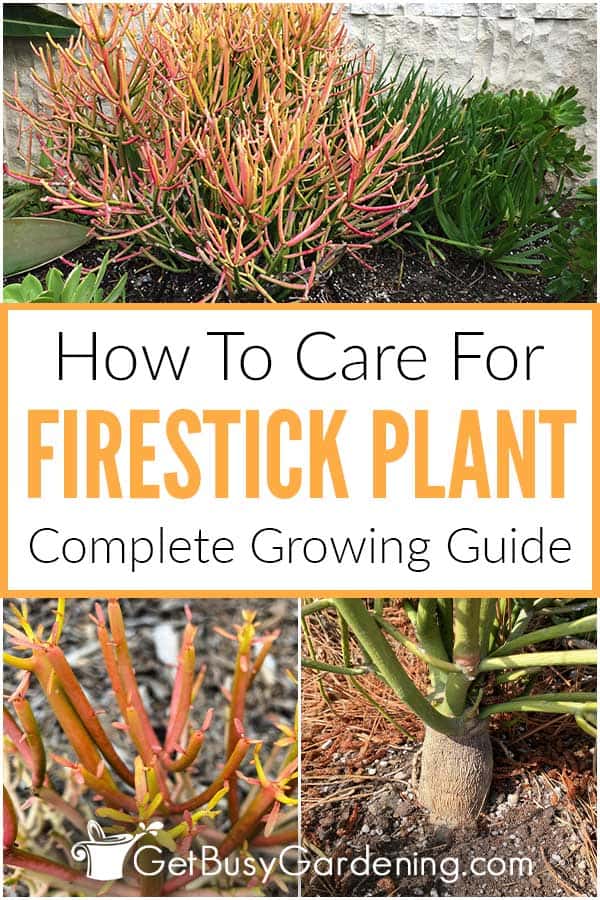
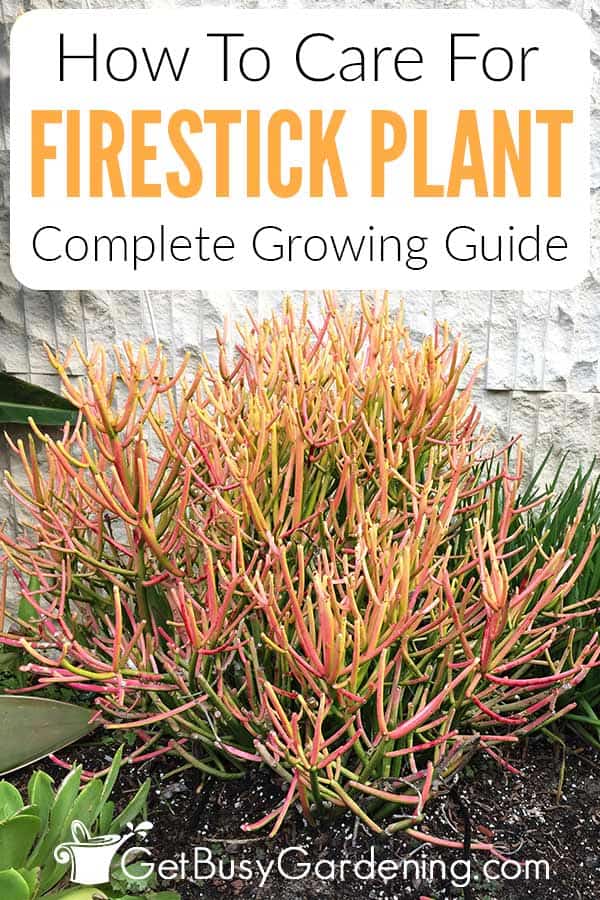




LYNN ANN GLICK says
I have several firesticks, all with good amounts of sun. The ones in the front yard look fine. The ones in the backyard look very deadline, slticks all hanging down as if dead. Should I remove them or will they recover? They are a very sad punch of firesticks.
Amy Andrychowicz says
Oh no, sorry to hear that your firestick plants are suffering! If the branches are brown and dead, then you can remove them. I would check the soil to make sure they aren’t getting too much water, it might be wetter in your backyard.
Don Meserve says
I live in Phoenix and have two Firesticks in pots that are 3-5 years old and over 3′ tall with multiple stems. I am ready to plant them in the ground. When is the best time to plant them in Phoenix at about 1700′ elevation? I know they can be damaged by freezing temperatures since another one died in a pot several years ago after a few cold nights.
Amy Andrychowicz says
Wait to plant your Firesticks outside until it warms up and all chance of frost is gone. But I would definitely get them in the ground well before the heat of summer kicks in. They can’t handle prolonged freezing temps though, so if that’s your norm during the winter, then you might want to keep them in pots so you can move them inside during cold snaps.
Linda Richardson says
I have a fire stick plant and it’s doing quite well and it has flowered several times grown several feet but now it has these little green balls on some of the end of the branches. I can’t find any information on this. Can you please help me
Amy Andrychowicz says
Those little green balls on the tips of the branches on your firestick plant are probably the start of flower buds. The blossoms are very small and insignificant and they look like little round balls before they open. 🙂
Danielle says
I have a thriving fire stick plant – 5′ x 2, and I want it to turn red. I have planted cuttings of red plants and they turn green withing 2 weeks. What’s your take on this?
Amy Andrychowicz says
Firestick plants require 6-8 hours of full, intense sunlight to keep their red/orange coloring. So make sure your cuttings are getting the same amount of sun as the mother plant.
Gene Prall says
Do you offer the the complete care book or can defect me to where I can get one?
I have two, so far, one up against a west facing block wall and the other about 10 feet west. They both turn gray on top, the one next to the wal;l l;ess than the other. I am guessing it is from the cold?? We are in Gold Canyon, had a few dips below freezing. I like them because they do wonderful while we are gone for 4 months.
Amy Andrychowicz says
I do not have a book about them, but maybe some day. 🙂 Firestick plant tips usually turn gray due to either overwatering or a fungal infection/mildew. If it’s being sprayed by a sprinkler or precipitation is dripping on it from an overhang, then that is probably what’s causing the problem.
Josie says
Hello! I’m new to succulent plants and I’ve been trying to find someone knowlegeable to help me. I took home a succulent dish garden with a firestick plant (someone at work was giving it away,) and it’s been under a plant light. A couple of weeks after bringing it home, I noticed it was developing greyish patches on the branches but couldn’t remember if they were there when I got it. Since then, the patches have spread over more of the plant, and it’s starting to get soft and floppy. I can’t find anything about these spots and I really don’t want it to die. If you can email me I can send photos. Please help!
Amy Andrychowicz says
Those grayish patches on your firestick plant could be scaring from either too much light (sunburn) or damage from moving it, but it could also be rot, or simply crusty sap. Since you said that it’s starting to get floppy and soft, then it’s either being over or under watered (if the spots are rot, then it’s getting too much water). Check the soil to make sure it’s never wet or soggy, it should dry completely before you water again. Also, make sure that your plant isn’t too close to the light. You can post photos on my Facebook page if you’d like, and I’ll take a closer look.